|
1.
CENTRAL/ WEST AFRICA
Clarification on Gabon log ban
At a recent meeting with Gabon¡¯s Minister for Forests,
executives of the country¡¯s timber industries were advised
of the official position concerning the ban on the export of
logs that was introduced as from 1st January 2010. The
meeting was told that the ban is irrevocable.
During the discussions estimates were provided of current
log stocks. These indicate that the volume of logs already
cut in the forest, in the industry log yards and those logs
currently being transported by rail and road is in the order
of 500,000 to 600,000 cubic metres.
It has been reported that logs that are already at the port
and in storage yards (rail storage and SEPBG storage
yards) can be exported immediately by industry to fulfill
existing contract commitments. Other log stocks can be
exported, but only through the State agency SNBG and not
directly by the industry. The existing log stocks can be
exported only up until the 30th April 2010. After that date
all log exports are banned.
The meeting heard that government policy is now to be
geared towards downstream processing, beyond sawn
lumber and veneers into finished products. It is expected
the industry will have to move into the production of
mouldings, components and semi-finished products.
It was reported that government is now considering ideas
for preferential customs tariffs, import and exports tax
incentives and other revenue incentives to attract inward
investment into downstream processing facilities.
As previously reported, some producers are now
considering re-starting work to complete the construction
of mills that were in the course of construction and reopening
others that were closed because of the downturn
in sawn lumber and veneer markets.
Relaxed log exports
The Cameroon government¡¯s relaxation of exports of
secondary log species from 5% up to a notional 30% of
production is said to be in response to industry concerns
over difficult market conditions for sawn lumber that has
led to revenues falling below break-even point in the
industry.
Mills cut production
Congo Brazzaville has a tightly controlled quota system
allowing only 25% of total log production to be exported
against 75% that must be domestically processed. Because
of the current worldwide downturn in the sawnwood
markets, some operators have been forced to reduce total
production as they are unable to sell the full 75% as milled
sawnwood.
Logs from Equatorial Guinea
Equatorial Guinea had previously implemented a total log
export ban but it is now reported that some log exports are
now being allowed. However, this is not likely to be of
significant volume.
No market disruption
So far as can be determined, the Gabon log ban has not
caused any major disruption in the market. Modest price
increases for okoume logs and for okan have been reported
but prices for all other timbers have not moved to any
large extent.
The Cameroon government action in releasing for export a
larger proportion of production, plus the now clarified
position for 3 months of log exports coming from Gabon
seems to have held the market prices stable.
The clarification of the situation in Gabon now gives
importers time to assess where and how to source future
log supplies and how their processing industries will have
to adapt to changing circumstances, much as the European
trade has done in that past decade by drastically reducing
log imports.

2. GHANA
Access to Global Climate Fund
The Minister of Environment, Science and Technology
has announced, that Ghana is to access a US$30 billion
global fund set aside by developed countries on climate
change. Funds would be used to implement climate change
related socio-economic activities.
The Minister said the government was in the process of
developing a low carbon emissions growth plan which
would anchor Ghana¡¯s sustainable development agenda.
According to the minister, Ghana has a low level of carbon
emissions compared to developed countries and even
when compared to the large developing countries but still
steps are needed to reduce emissions further.
The government aims to reduce deforestation and forest
degradation and has also committed one per cent of the
District Assemblies Common Fund to a massive tree
planting programme.
Economy to grow 5.7%
Ghana¡¯s economy is expected to grow by at least 5.7
percent this year, compared to the 5% achieved in 2009.
This should be possible as the global economy is
stabilising and Ghana will begin oil production this year.
The oil reserves found are estimated to contain 1.8 billion
barrels of crude oil. The government is now considering
setting up a sovereign wealth fund for some revenues
generated from oil sales.
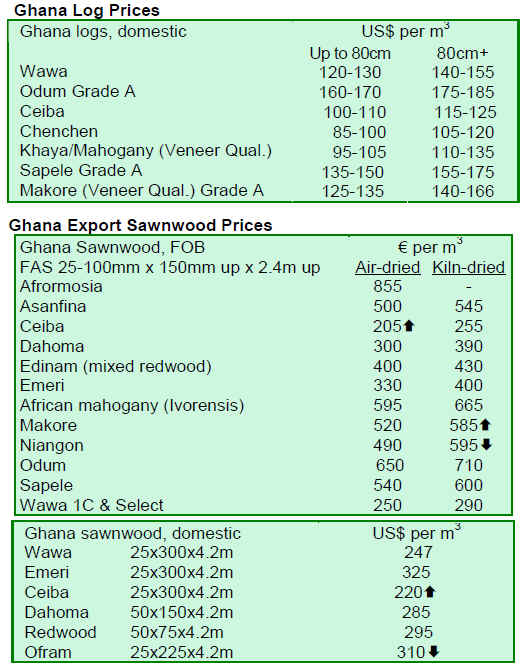
3.
MALAYSIA
Malaysia progresses with VPA
The advisor to the Malaysian Ministry of Plantation,
Industries and Commodities said that progress has been
made in the negotiation between the European Union (EU)
and Malaysia concerning the Voluntary Partnership
Agreement (VPA).
The advisor added that further consultation between the
various stakeholders in the country needed to be held
before the agreement is concluded.
The Ambassador and Head of the EU mission commented
that, apart from a few technical issues that needed to be
resolved, he wass hopeful that VPA will be concluded
between June and July 2010.
If that is the case, Malaysia will be the first country in
Asia to conclude the agreement. It will also provide
Malaysian timber products with smoother access to the EU
market.
Timber export recovery
Malaysia is expecting commodity exports, particularly
exports of timber products, to recover in line with the
economic recovery in both the EU and the US.
Exports of Malaysian commodities declined from RM112
billion in 2008 to only RM90 billion in 2009 due to the
global economy slowdown.
Demand for Malaysian timber fell from RM22.8 billion in
2008 to RM19.8 billion in 2009.
Exporters cautious
Malaysian timber exporters are closely watching
developments in the EU and US markets. Currently
economic recovery in the two main markets is considered
weak and may not be sustained.
With the US dollar weakening against the Malaysian
ringgit, timber exporters will face a tough time in the US
market if they cannot trim prices.
In addition, because of the advantageous exchange rate of
the Chinese renminbi against the US dollar, competition
from Chinese manufacturers, especially of furniture, will
continue to be fierce.
New Year slow down
Prices of Malaysian timber products remain relatively
stable as most businesses wind down for the annual
Chinese Lunar New Year holidays.
Price increases for sawn rubberwood lead the charge as
there has been less felling of rubberwood trees because
prices of natural latex rubber continues to climb upwards.
The sharp rise in prices for natural rubber and palm oil
could lead to a sharp drop in the supply of rubberwood
logs and oil palm fibres.
A prolonged shortage of rubberwood logs may take root
and this could impact the local furniture and panelproducts
industry after the Chinese New Year holiday.

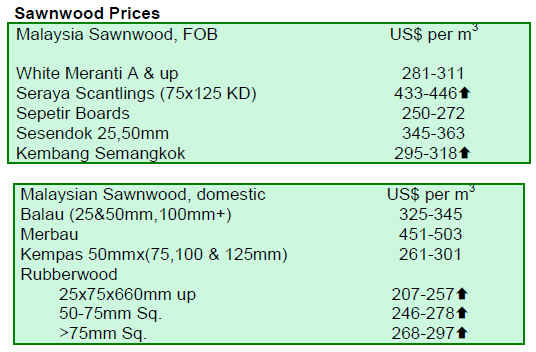
4.
INDONESIA
Plywood push in India
Indonesian manufacturers are working hard to further
penetrate the Indian plywood market according to the
Indonesian Wood Panel Association (APKINDO).
India imports up to 16 million cubic metres of timber
annually, domestic consumption is currently around 95
million cubic metres. According to APKINDO, Indonesia
is in a strong position to compete for a bigger share of the
Indian market for 2.7 mm thickness plywood which is in
high demand in India.
Certification in Kalimantan
Reports suggest some large timber concessionaires in
Kalimantan are seeking certification as part of their
corporate governance development to try and secure a
long-term future in the sector.
Certification is also seen as a means for providing job
security as well getting production onto a more sustainable
track.
Reports indicate that some concessionaires have
approached The Borneo Initiative
(www.theborneoinitiative.org/about_tbi.html), a Dutch
non-governmental organization specializing in sustainable
forest management. This organisation apparently provides
support during the certification process which will be via
the Indonesian Ecolabeling Institute.
Up to one million ha. of forests are said to be ready for
certification, with 600,000 ha. in Kalimantan alone.
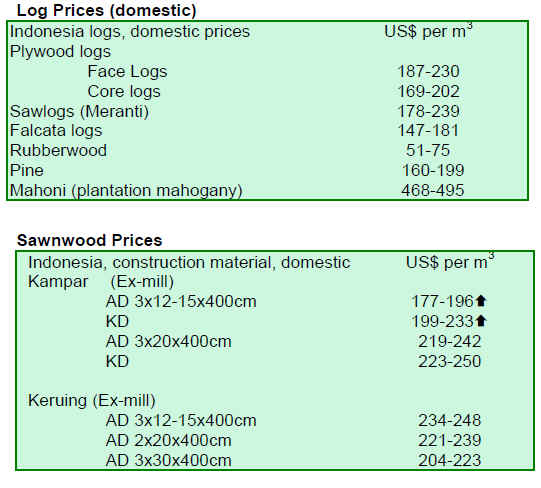
5.
MYANMAR
Buyers now have more choice
The trade is saying that market conditions remain almost
the same as reported in January. The demand for Teak and
Gurjan remains firm and Pyinkado logs are still selling
very well.
At this time of year fresh logs have started arriving at the
log depots and buyers will now become more selective,
given the wider choice of grades.
Timber pundits often predict that buying activity will slow
down after the Myanmar New Year in April when there is
an even better choice of more fresh logs.
Demand influenced by neighbours output
Export trends in the neighbouring timber producing
countries play a crucial role in forming buyer sentiment.
For example, buyers say that prices of Pyinkado climbed
recently mainly because Malaysia and Indonesia are
selling much lower volumes of similar hardwood species
like Merbau, Balau, and Selangan Batu.
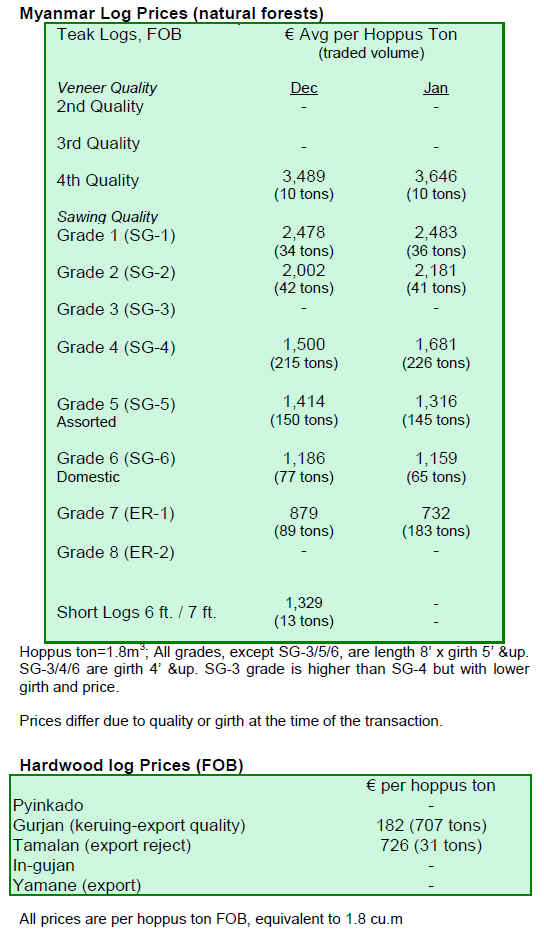
6. INDIA
Call for lower import duties
A submission to the ministry of finance by the timber
sector for changes in import duty levels in the next
national budget has been made. A reduction in the
maximum duty from 10% to 7.5% will help lower
production costs and thus make exports more competitive
says the industry.
Such a reduction would also help the government meet its
commitment to align import duties to Asean levels, say
analysts. The Indian government has progressively
reduced the import duties over the past decade and the
eyes of the timber industry are on the 26th February
deadline for the budget announcements.
Jatropha plantations
Indian Oil Co. is looking to acquire 50,000 hectares of
wasteland in various Indian states. They have reportedly
already acquired 30,000 ha. in Chhatisgarh and another
2,000 ha. in Madhya Pradesh. The company is seeking
more land in Uttar Pradesh for planting Jatropha.
Jatropha is resistant to drought and most pests and
produces seeds containing 27-40% oil. After oil extraction
the residue could also be considered for energy
production.Jatropha curcas oil has potential for biofuel production.
Government policy may involve financial incentives for
forest plantations as they will help the country meet its
carbon emission mitigation targets absorb carbon, extend
green cover and provide a bio-fuel option.
Interest in rubber plantations
With natural rubber prices having doubled in a year, from
Rs65 per kg last year to Rs128 per kg today, rubber
plantations will also get a boost. Besides rubber, the trees,
once latex yields fall to uneconomic levels, provide log
raw materials for the wood based industries.
India¡¯s trade statistics
India¡¯s log imports for fiscal 2008-9 are reported by
CAPEXIL at 3,875,300 cubic metres as against 3,931,400
cubic metres during 2007-8. Value-wise 2008-9 imports
were Rs. 51, 264 million as against Rs. 47,124 million for
2007-8 a rise of almost 9% despite the economic
downturn. Imports of sawn timber have seen a steep rise
from Rs. 1,025 million in 2007-8 to Rs. 1,449 million for
2008-9.
On the export front there has been a sharp increase (86 %)
in shipments of sawn timber and a 29 % rise in exports of
other articles of wood. These increases have helped offset
the declines in exports of plywood and wooden furniture.
CAPEXIL, a non-profit making organization, was setup in
March 1958 by the Ministry of Commerce, Government of
India to promote export of chemical and allied products
from India. And since then has been the voice of Indian
business community.
Total exports of wood and wooden products rose
marginally by 2.5 % during 2008-9 and stood at Rs. 20,
118 million as against Rs. 19, 620 million for 2007-8.
Exports of wooden furniture, mainly antique reproduction
styles are not covered by Capexil but other sources
indicate exports in 2008-9 of around Rs. 8, 000 million.
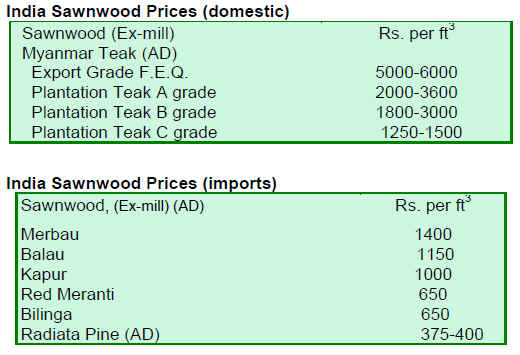

7. BRAZIL
Illegal sawnwood seized in Par¨¢
IBAMA has reported that about 800 cubic metres of
sawnwood was seized at Bel¨¦m port in mid-January. This
volume is equivalent to more than 30 truckloads and
comprised Amazonian timber species, such as quaruba
cedar, angelim, cupi¨²ba and mandioqueira.
According to the information provided by IBAMA, the
timber company involved has a history of trading in
illegally sourced timber. The company had been given a
warning in 2005 but apparently did not take any action to
comply with environmental legislation.
The market price of the seized timber was reportedly much
lower than that for timber harvested legally, this distorted
the market and made trading in legal wood products that
much more difficult.
Forest residue targets for industry
Members of the Par¨¢ Timber Exporters Association
(AIMEX) met with representatives of the State Secretariat
of Environment (SEMA) to discuss recommended
modifications to the forest licensing system in the state.
The main issue raised by AIMEX was the wood yield
conversion factor being applied. The current rate applied
was determined by the National Council for the
Environment (CONAMA) and is 45% log to sawnwood, a
rate that has been generally accepted since the application
of the 2009 State Forest Control System (Sisflora).
The current rate for forest residues is set at 13.0% but
there is a proposal to lower this to 2.25%. However,
AIMEX argues that a rate of 2.25% does not represent the
reality of the Para¡¯s timber industries.
AIMEX stressed that a federal resolution by CONAMA
established a conversion rate of 45% (log to sawnwood),
but it leaves the determination of forest residue conversion
rates up to each State.
Alta Floresta timber exports down
Data from the Ministry of Development, Industry and
Foreign Trade (MDIC) show that wood products exports
by companies in Alta Floresta dropped sharply in 2009.
Wood products are the best selling product in Alta Floresta
but sales in 2009 were low.
Exports of non-coniferous wooden parts were 6% lower in
2009 compared to 2008. In 2009 exports were worth
US$11.1 million against US$ 11.8 million the previous
year. The decline in sawnwood and veneer exports was
even greater, dropping by almost 80%; from US$ 1.9
million in 2008 to just US$363,800 in 2009.
On the other hand, exports of wood products such as
blocks, planks, strips, profiles did well in 2009 compared
to 2008.
The main consumers of wood products from Alta Floresta
in 2009 were the United States (US$6.5 million), Canada
(US$2 million) and Spain with US$1.2 million. The US
and Spain cut back their imports from the region by 14%
and 42%, respectively. Canada, in turn, expanded imports
from the region.
Timber industry on recovery path
Brazilian timber exports now seem to be recovering.
While the overall picture for 2009 was bleak, with a 45%
drop in the value of exports compared to 2008, data for
December 2009 showed a marked improvement.
Export values in December 2009 were close to the same
period of 2008 (around US$38 million). In the second half
of 2009, Brazilian timber exports were US$ 172.7 million
and although this represented a 34% drop on 2008 this was
an improvement on the first half numbers, signaling that
markets are beginning to recover after the global economic
crisis.
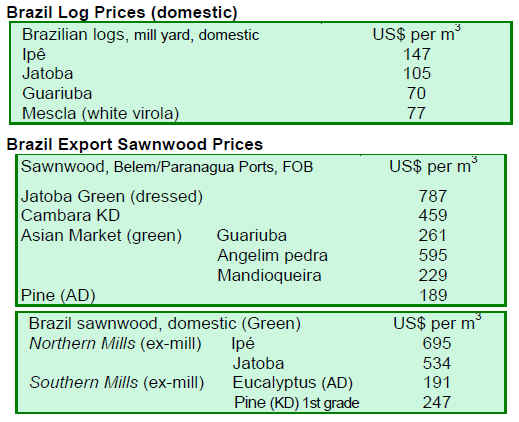
8.
PERU
Forest law review
The Ministry of Agriculture has decided to extend until 31
March this year, the deadline for the General Directorate
of Forestry and Wildlife to complete the updating of the
forest and wildlife law.
In July 2009, the Ministry of Agriculture launched a
review and update of the Forestry and Wildlife law within
the framework of a decentralized participatory process at
national level. The new draft law will contain proposals
for change and will be termed the National Forestry Policy
and Law Project for Forestry Policy and Law Project and
Wildlife.
Stepping up concession monitoring
The Agency for Supervision of Forest Resources and
Wildlife (OSINFOR) has started to undertake monitoring
of forest concessions, this began in Inapari, Madre de
Dios, where concessions extend to 1.2mil ha. The
monitoring began in the SAC Pumaquiro timber forest
concession located in Inapari, Tahuamanu province. Peru
has 556 forest timber concessions, covering 7.1 million
hectares and the aim is for intensive monitoring to cover
all forest concessions.
Tough stance on concessions
Richard Bustamante, president of the Agency for
Supervision of Forest Resources and Wildlife (OSINFOR)
has indicated that, following the 2009 monitoring of 78
forest concessions, it found that 46 of the 78 have
breached the concession contracts.
Because of this OSINFOR has initiated an administrative
process to address these contract breaches and some 44 of
the errant 46 concessionaires could have the concession
agreements declared invalid. The defendants could not
only lose the concession, but also could also be fined.
Some forest concessions could be declared cancelled "due
to violation of their annual operating plans and general
forest management plans, as they are removing more wood
than they should¡±.
OSINFOR president also reportedly said that "it is
necessary to take stock of the progress to date and identify
and correct the negative aspects for future concessions. In
addition, we must discuss how we can turn wood into
products with a high added value¡±.
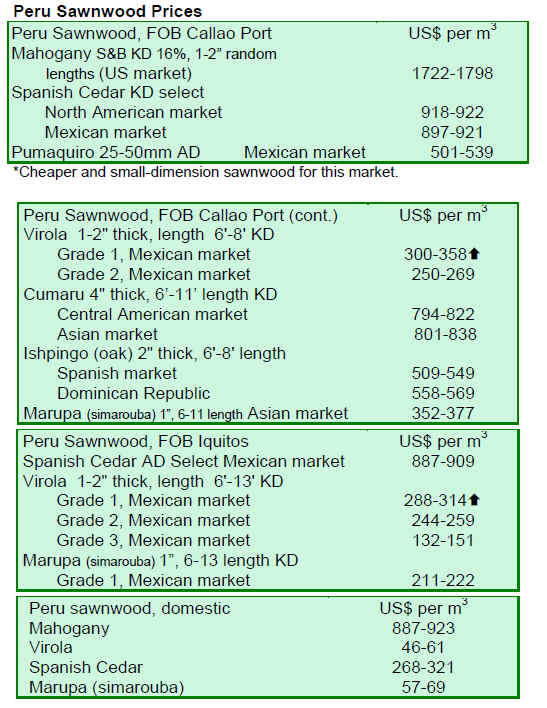
8.
Guyana
Encouraging trends continue
The positive market sentiment continues and the trend
towards more processing and lower log exports seems to
be gaining momentum. There was some trade in
Purpleheart logs and prices remain stable.
There was encouraging and positive production of rough
sawn (undressed) Greenheart, and average prices moved
up reaching as high as US$900. Sawn Purpleheart
(undressed) saw active buying for only Select grades with
very satisfactory average prices.
Mora sawnwood continues to be traded at stable prices.
Dressed Greenheart sawnwood achieved favourable prices
recently between US$742-827 which is better than during
the previous two weeks.
The demand for Baromalli plywood has been positive and
price levels have encouraged producers with
improvements in prices for both the BB/CC and Utility
grades.
For the period up to the end of January, export of value
added products has been good and this has contributed
significantly to total export earnings. The market has been
firm for products such as doors, mouldings, outdoor
garden furniture, spindles, and wooden utensils. The main
species used for added value production include
crabwood, (andiroba) locust, (courbaril) and purpleheart.
Industry reassured of support
The growing and expanding role of the Guyana Forestry
Commission (GFC) in ensuring that forests are pivotal to
mitigating climate change, will be performed without
compromising its support and promotion of the timber
industry, according to a statement released by the Ministry
of Agriculture.
Over the past two years efforts have been made to
strengthen the capacity of the GFC to address climate
change issues such as Reduced Emissions from
Deforestation and Degradation (REDD) and Guyana¡¯s
Low Carbon Development Strategy (LCDS).
However, the GFC has not lost sight of its goal of
achieving a competitive and sustainable wood processing
sector where the emphasis is on valued-added products.
The Forest Products and Marketing Development Council
(FPMDC) was established to focus on the development
production capacity and markets for wood products and to
encourage investments in the sector.
According to the Minister of Agriculture ¡°notwithstanding
our efforts in terms of looking for incentives arising from
the role our forests play in climate change mitigation,
there will continue to be a role for the forestry sector. The
changes will not affect the timber sector in any way that
will see it downsized or lead to loss of jobs or closure. In
fact, the measures will allow growth within the context of
the emphasis on sustainable forestry management.¡±

|